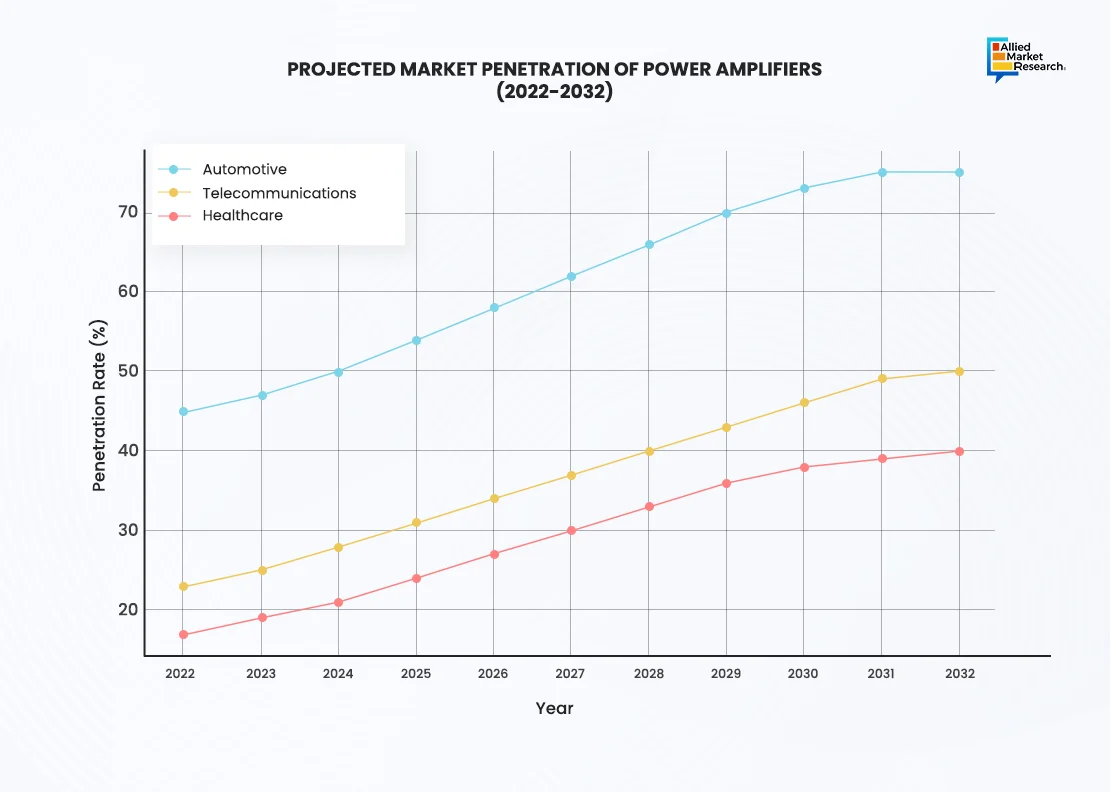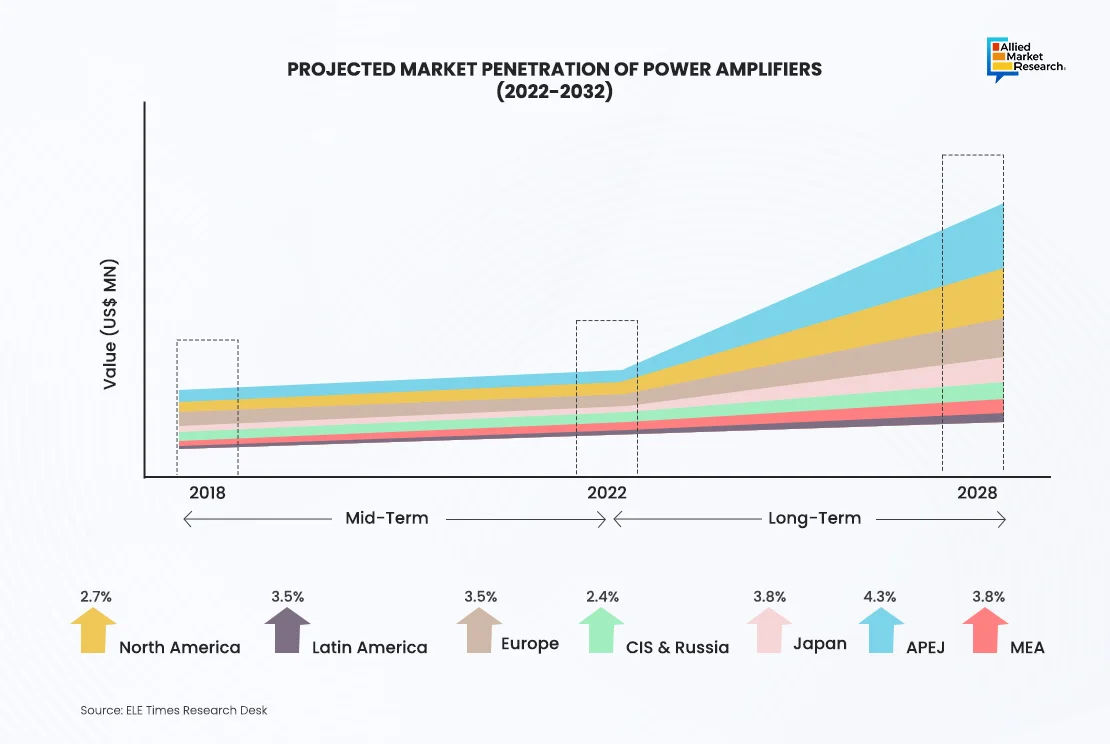Table Of Contents
- Amplifying Power Amplifiers
- Electronic Marvel Magnifying the Strength of Signal
- Pioneers Paving Way for Future Development
- Automotive Sector
- Telecommunications Sector
- Healthcare Sector
- Key Financings to Foster the Future
- Power Amplifiers Empowering Existing Technologies
- Navigating the Challenges
- Trends Transforming the Power Amplifier Market
- The Verdict

Onkar Sumant

Akshata Tiwarkhede
Power Amplifiers: Empowering Connectivity

Power amplifier has experienced a remarkable evolution in the recent decade driven by rapid technological advancements and innovations. These devices provide enhanced power density and efficiency by using cutting-edge technologies such as silicon carbide (SiC) and gallium nitride (GaN), thereby facilitating higher performance across various industries, including telecommunication, aerospace & defense, and healthcare. Thus, the integration of advanced power amplifiers empowers critical systems of these industries to achieve higher functionality and efficiency.
Amplifying Power Amplifiers
In the late nineteenth century, J A Fleming, along with associate scientists, invented the first vacuum tube—an electronic device that uses vacuum to control the flow of electric current between its electrodes. The advent of vacuum tube served as a critical development as it paved way for later inventions, including transistor and integrated circuit, which have revolutionized the electronic device industry. Although vacuum tubes have replaced power amplifiers in modern electronics, they are still used in guitar amplifiers and high-power radio transmitters.
Electronic Marvel Magnifying the Strength of Signal
One of the notable achievements in this domain is the development and integration of envelope tracking technology into power amplifiers. Envelope tracking is a technique used to improve the efficiency of power amplifiers by dynamically adjusting the supply voltage based on the input signal's amplitude, thereby minimizing power wastage and enhancing overall performance.
An exemplary instance of envelope tracking integration is the Qualcomm® Snapdragon™ X60 5G modem-RF system. This system incorporates advanced envelope tracking technology to optimize the efficiency of its power amplifiers, enabling faster data speed, extended battery life, and enhanced network connectivity for mobile devices. By dynamically adjusting the supply voltage in real time, the Snapdragon X60 system achieves unprecedented levels of power efficiency and performance, setting new standards in the realm of wireless communication.
Moreover, NXP Semiconductors—a key manufacturer of integrated circuits, microcontrollers, logic, wireless, discretes, and microprocessors—rolled out gallium-nitride (GaN)-based RF power amplifiers. This new series of RF modules facilitate top-side cooling, handle the higher power levels of 5G base stations without overheating, reduce the thickness and weight of radios in 5G base stations by more than 20%, and feature high efficiency of 46% over 400 MHz of instantaneous bandwidth. According to Pierre Piel—NXP’s VP and GM of Radio Power—“Top-side cooling represents a significant opportunity for the wireless infrastructure industry, combining high power capabilities with advanced thermal performance to enable a smaller RF subsystem.”
Thus, these developments in technology have laid a robust foundation for future market growth, and are collectively expected to create a fertile environment for driving economic prosperity and fostering a culture of innovation.
Pioneers Paving Way for Future Development
The landscape of power amplifier technology has undergone significant transformation in response to evolving market demands and technological advancements. Historically, power amplifiers were primarily utilized in telecommunications and broadcasting applications, where high-power output and signal fidelity were paramount. However, with the proliferation of mobile devices, Internet of Things (IoT) devices, and wireless communication systems, power amplifiers are gaining ground in diverse sectors such as automotive, healthcare, and industrial automation.

Automotive Sector
In the automotive industry, power amplifiers are crucial for the operation of radar and LiDAR systems, which are integral for the development of autonomous driving technologies. These systems enable vehicles to perform complex operations such as adaptive cruise control and collision avoidance autonomously. Moreover, they enhance the quality of audio systems in modern infotainment setups. Their reliability, efficiency, and compact design are paramount due to the diverse and harsh environmental conditions in which vehicles operate. Hence, the anticipated growth in this sector is significant, with penetration reaching from 23% in 2022 to around 50% in 2032 as more vehicles are integrated with advanced driver-assistance systems (ADAS).
Telecommunications Sector
The telecommunications sector has seen significant evolution with the deployment of 5G networks, necessitating the use of power amplifiers that can handle higher frequencies and wider bandwidths. These capabilities are critical for supporting data-intensive applications such as ultra-HD video streaming, massive IoT deployments, and low-latency communications required for real-time applications. Thus, the penetration of power amplifiers in this sector increased from 45% in 2022 to over 75% in 2032, fueled by continued advancements.

Healthcare Sector
In the healthcare sector, power amplifiers enhance the performance of medical imaging devices such as ultrasound and MRI, and are vital in patient monitoring systems, particularly in wearable health technologies. These amplifiers ensure the precise and reliable amplification required for accurate diagnostics and continuous health monitoring. The penetration rate in the healthcare sector increased from 17% in 2022 to approximately 40% in 2032, driven by the broader adoption of technology-enhanced healthcare solutions.
Key Financings to Foster the Future
Falcomm—a semiconductor start-up based in Atlanta, Georgia—is developing a new type of power amplifier to minimize energy consumption in hardware ranging from consumer products such as smartphones and IoTs to Wi-Fi networks and satellites. The co-founder and CEO of Falcomm, Edgar Garay says “workhorse of the modern electronic era” delivers efficiency levels over 50% at 28 GHz as compared to competitors’ 25–35%. Thus, investors are providing heavy funds for the development of Falcomm’s technology to supercharge power amplifiers. The start-up, which was one of the Startup Battlefield 200 companies in 2023, signed a term sheet with Squadra Ventures and closed a $4 million deal on September 22, 2023.
In March 1, 2024, the Union Cabinet of India approved an investment of Rs 1.26 trillion for three semiconductor plants, aiming to boost the nation's position in global semiconductor manufacturing. This significant financial venture includes the establishment of Tata Group's major chip fabrication unit in Dholera, Gujarat with a partnership with Powerchip Semiconductor Manufacturing Corp from Taiwan, another Tata chip assembly plant in Morigaon, Assam, and a CG Power semiconductor unit in Sanand, Gujarat, in collaboration with Renesas Electronics Corporation, Japan, and Stars Microelectronics, Thailand. The projects are set to create 26,000 direct advanced technology jobs and approximately 100,000 indirect jobs, reflecting a substantial economic impact and advancing India's technological infrastructure on a global scale.
In June 12, 2023, Amp Energy India, a key player in the renewable energy sector, announced a substantial investment of $250 million from Japan’s Sumitomo Mitsui Banking Corp. (SMBC), the Asian Infrastructure Investment Bank (AIIB), and Intermediate Capital Group (ICG). The funding, confirmed by CEO Pinaki Bhattacharyya, is set to boost the company’s expansion efforts across Europe, India, Japan, the U.S., Canada, and Australia. The investment will support Amp Energy India’s commitment to enhance its renewable energy capacity in line with India’s ambitious goal of achieving 500 GW installed renewable energy capacity by 2030 as part of its broader strategy to reach net-zero carbon emissions by 2070.
Thus, financing plays a pivotal role in shaping the future of the industry by providing essential capital for research, development, and expansion initiatives. It will further enable businesses to invest in cutting-edge technologies, talent acquisition, and market expansion strategies, driving innovation, competitiveness, and sustainable growth in the coming future.

According to ELE Times—a publication providing news and insights related to electronics and electrical engineering—the RF power amplifier market is likely to witness threefold (3.2x revenue growth) growth from 2018 to 2028. Asia-Pacific (excluding Japan) acquires a substantial share of the market (indicated as less than 50%), whereas North America accounts for over one-fourth of the total market value. Thus, surge in deployment of 5G networks, increase in penetration of smart devices, and advancements in semiconductor technology are indicative of the market's evolving dynamics.
Power Amplifiers Empowering Existing Technologies
Power amplifiers are set to play a vital role across a wide array of industries.
- 5G Infrastructure: For high-speed, minimal latency connections with potential capabilities in self-driving cars, telemedicine, and smart city applications, 5G network-optimized power amplifiers will be essential.
- IoT Connectivity: Power amplifiers play a crucial role in IoT connectivity by establishing a reliable wireless communication between IoT devices and network infrastructure. By extending their range and improving communication reliability, these amplifiers boost the transmit power of IoT devices, especially in scenarios with obstacles or interference.
- Satellite Communication: Power amplifiers play a crucial role in satellite communications by boosting the power of signals, ensuring strong and clear transmission over vast distances. This improvement in signal strength is essential for high-throughput data transfer to enable efficient satellite internet connections, improve the capabilities of remote sensing, and support accurate navigation systems.
- Wireless Healthcare: To improve remote patient monitoring, diagnostics, as well as treatment delivery in the healthcare sector, wireless medical devices and telemedicine solutions are embedded with power amplifiers.
Navigating the Challenges
Although power amplifier is gaining high traction, it is not without its share of challenges. These obstacles, however, present avenues for inventive solutions and strategic advancements. As the demand for wireless connectivity keeps growing due to applications such as 5G, IoT, and autonomous vehicles, the need for spectrum allocation becomes fierce. The scarcity of available spectrum serves as a major challenge among the manufacturers. This shortage requires the innovation of solutions that maximize spectral efficiency to enable reliable power amplifiers to work within limited frequency bands but still be able to meet high-speed data transmission requirements.
To effectively overcome this challenge, it is crucial to focus on developing power amplifiers that are more spectrally efficient, ensuring optimal use of available frequency bands to meet the increasing demand of modern wireless applications.
Furthermore, thermal management becomes a critical issue as power amplifiers evolve to be more powerful and compact. The concentration of power into smaller form factors aggravates the problem of heat dissipation, which may lead to poor performance and unreliability. To prevent overheating and maintain constant operations under different environmental conditions, the need for efficient thermal management solutions is increasing considerably. To overcome this issue, key players are heavily investing in innovations in heatsink design, material science, as well as active cooling technologies, which increase the efficiency and service life of amplifiers. Moreover, improvement in simulation and modeling techniques has enabled predictive thermal analysis resulting in manufacturers optimizing their amplifier designs for better thermal performances.
To foster innovation, collaboration, and market expansion, manufacturers leverage advanced technologies and strategic partnerships to shape the future of connectivity and communication. Through the incorporation of latest developments in semiconductor technology, RF circuit design, and system integration, innovative amplifier architectures can be developed that will offer an edge over competitors by boosting the performance levels well above average while maintaining high efficiency and reliability.

Trends Transforming the Power Amplifier Market
The power amplifier market is poised for significant transformation driven by emerging trends that have the potential to reshape the industry landscape.
- Integration of Advanced Semiconductor Technologies: The application of advanced semiconductor materials such as gallium nitride (GaN) and silicon carbide (SiC) is about to bring a revolution in power amplifier design. These materials are characterized by better performance concerning efficiency, power density, and bandwidth, making it possible for manufacturers to develop amplifiers meeting the ever-increasing need for fast and reliable connectivity across a wide range of applications.
- Enhanced Thermal Management Solutions: The increasing power and reducing size of power amplifiers necessitate effective management of their heat. Therefore, manufacturers are currently seeking innovative cooling technologies such as liquid immersion cooling systems, where components are submerged in a non-conductive liquid to emit heat effectively. This approach helps to ensure that amplifiers perform optimally and reliably across different environments. Investing in R&D on thermal management offers a competitive edge by differentiating the product line of companies.
- Integration of Beamforming and MIMO Technologies: The incorporation of beamforming and multiple-input multiple-output (MIMO) technologies strengthens the capacity, coverage, and spectral efficiency, in wireless communications systems specifically within 5G networks. This high-performance demand can be capitalized by manufacturers by using beamforming-enabled power amplifiers to meet the needs of future wireless infrastructure deployments.
- Focus on Energy Efficiency: The importance of energy-efficient power amplifier designs is increasing due to concerns over power consumption and battery life in mobile devices and IoT applications. Manufacturers are focusing on amplifiers with better efficiency, using advanced semiconductor technologies, and unique circuit architectures to reduce energy use and improve overall device performance. Companies can provide energy-saving products that meet the sustainability preferences of consumers as well as support environmental preservations.
The Verdict
Power amplifiers serve as essential components of electronic devices, as they play central role in amplifying signals. AI-enabled power amplifiers could pave the way for smarter, more adaptive systems that can self-diagnose issues, self-optimize for various inputs, and even learn from user preferences over time. As this technology continues to evolve, it holds immense potential to transform numerous industries in the coming future. Thus, the future holds the promise of more advanced and efficient power amplifiers, thereby opening new avenues in communication and audio technologies.

